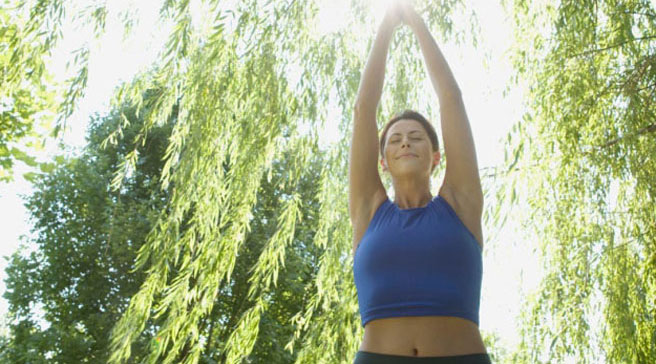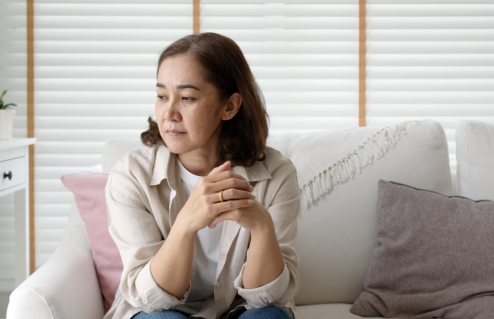The power of standing still
Rebecca Hardy discovers how meditation without movement could be one of the most efficient forms of exercise, benefiting mind and body

We’re so used to the idea of ‘doing’ to be effective that standing still and doing nothing sounds rather strange. But, according to zhan zhuang qigong therapists, simply standing still can energise and realign us more than physical exercise, which they say can drain our energy and put too much pressure on the body.
The idea behind this type of ‘stand like a tree’ qigong is that the less physical movement you make, the easier it is for your chi (or life force) to circulate freely round your body. ‘Standing meditation is one of the fundamental training methods of internal Chinese martial arts,’ says Yang Yang, founder of the Center For Taiji And Qigong Studies in the US and author of Taijiquan: The Art Of Nurturing, The Science Of Power. ‘Practitioners hold standing postures to cultivate mental and physical relaxation, tranquillity, awareness and power. The Chinese call it zhan zhuang or standing pole, while the t’ai chi form is called moving standing pole.’
There are various theories about its origins, but one of the earliest descriptions of standing pole comes ?from a Chinese medical textbook written sometime around 403 to 200BC. ‘One theory is that it is one of the oldest exercises in human history,’ says Yang. ‘Prehistoric man had to stand perfectly still for long periods when hunting. It is an interesting thought. I have had deer, coyotes, birds and foxes pass close to me while I have been standing.’
Stand, relax and sway
The practice works like this: after some gentle warm-up moves you stand quite still and relaxed, with all your joints open (see below). This releases blocks of tension and strengthens your core muscles, allowing your energy to flow freely. The more still you are on the outside the more movement can happen within. ‘It’s like taking a magnifying glass and watching movements in more detail in the body, so you notice where there is tension,’ says Karel Koskuba, co-author of Tai Chi For Every Body and chief instructor at the Chinese Internal Arts Association. ‘After a while you may start to sway. Simply stand, relax and sway.’
It sounds simple, but fans say this art of standing helps them relax, feel more confident and they are quicker to spot stress-related tensions that they can then clear. They also claim it has physical benefits. ‘Standing meditation improves core strength, balance, bone density, power, awareness, sleep quality, body alignment, efficiency of movements, and mind-body connection,’ says Yang.
He has conducted research studies into t’ai chi (closely related to qigong), including standing, at the Kinesiology faculty at the University of Illinois in the US, and found significant improvements in balance, strength, immune function and wellbeing. ‘In one of my research projects, the lower-body strength increased by about 20 per cent after six months of taking part in a one-hour class, which included about 20 minutes of standing, three times per week.’
Another study in China, by Professor Yu Yong-Nian, of Teh Lu Hospital in Beijing, showed a marked increase in the protein of red blood cells after one hour of standing, providing an increased flow of oxygen to different organs and allowing the whole body to feel relaxed.
‘Standing meditation flies in the face of most of our ideas of how we think exercise ought to be,’ says Sam Moor, who teaches t’ai chi in Brighton and Chichester. ‘We may go running, for example, and when it becomes painful we think, “This is good, this is proof that I am working my body hard”. But by standing still, we notice much more about how the body functions and works as one unit.’
Muscle imbalance
It is also, he says, a practical exercise that can help counter many everyday perils, such as sitting hunched over a computer, carrying a toddler or gardening. ‘There’s a misconception in the West that t’ai chi is a spiritual discipline, but standing still is a very physical exercise.’
According to t’ai chi practitioners, this is a common observation. Koskuba says that standing meditation teaches the body to use muscles in what he calls a ‘postural’ way (to hold a posture), rather than a ‘phasic’ way (when a muscle is used for movement).
‘Postural muscles react against gravity and act outside our volition. We cannot normally control postural muscles directly, only indirectly, through intent, like when we learn to ride a bike. If you try too hard you will keep falling off. It is only when you relax that you can learn to ride. If we don’t use postural muscles, the brain switches over to using tension-inducing phasic muscles that, if used all the time, can result in a bad back, arthritis, stiff joints, even depression.’
Tension release
So how can we learn to practise zhan zhuang? Opening The Energy Gates Of Your Body by Bruce Frantzis describes standing postures in detail, but to try the most common standing position, ‘holding the ball’, follow the instructions below. ‘Complete beginners will find it difficult to stay still in the position and still be relaxed,’ says Moor. ‘Start off for two or three minutes and over a month build to 10 to 15 minutes. The position very gently opens the body tissues, gently stretching and releasing tension.’
Practise standing still every day, says Yang, and you will soon start to feel the benefits. ‘I have been doing standing meditation daily for more than 25 years and I am amazed by the results. I am more relaxed and have more energy, agility, power and tranquillity. I sleep better, feel happier and am much more at peace.’ It may be hard to believe that all this could come from simply standing, but, in the words of the ancient Chinese, ‘If you do not practice stillness, you will never truly know the miracle of movement’.
Holding the ball
This exercise is the most common standing position and ideal for beginners.
• Stand comfortably with feet hip-toshoulder-width apart, with the knees slightly bent (ie unlocked) and hips and spine relaxed, as if you were lowering yourself onto the edge of a high stool.
• Gently raise your arms to mid-chest height as if holding a large delicate ball, with the hands relaxed and fingers lightly extended.
• Imagine there is a balloon between your knees, and your head is suspended by a piece of string.
• Breathe softly and quietly, preferably through the nose.
• Feel and observe the body and mind, gently encouraging the whole body to soften without letting the posture collapse or becoming rigid or tense.
• Hold for two to three minutes, gradually building up to 10 to 15 minutes a day.









